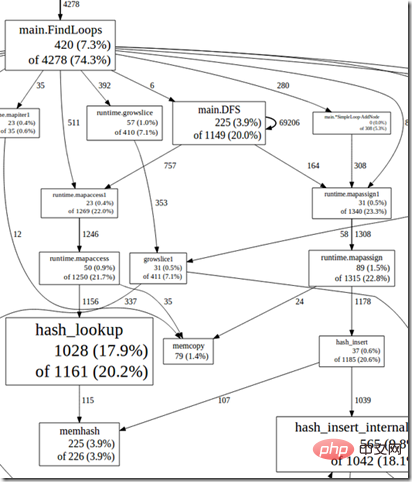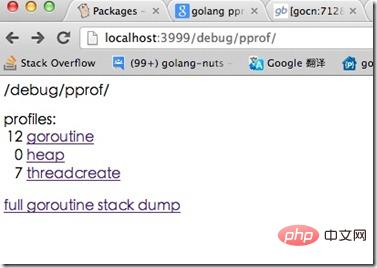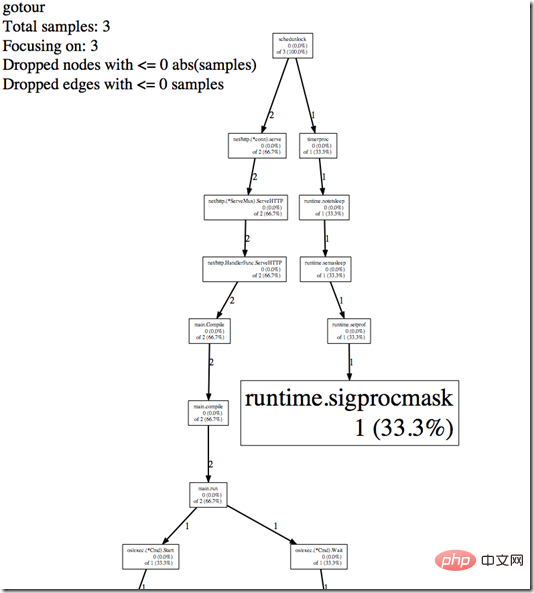Completely master how to use pprof in Go

go has the pprof package for code performance monitoring. There are packages in two places:
net/http/pprof
runtime/pprof
In fact, net/http/pprof just uses the runtime/pprof package to encapsulate it and expose it on the http port
pprof package
Web server
If your go program is a web server started with the http package, you want to check the status of your web server. At this time, you can choose net/http/pprof. You just need to import the package_"net/http/pprof".
Then you can use http://localhost:port/debug/pprof/ in the browser to directly see the status of the current web service, including CPU usage and memory usage. For specific usage, you can read godoc's instructions.
Service process
If your go program is not a web server, but a service process, then you can also choose to use the net/http/pprof package, which is also introduced Package net/http/pprof, and then open another goroutine to enable port monitoring.
For example:
go func() {
log.Println(http.ListenAndServe("localhost:6060", nil))
}()Application
If your go program is just an application, such as calculating the fabonacci sequence, then you cannot use net /http/pprof package, you need to use runtime/pprof. The specific method is to use pprof.StartCPUProfile and pprof.StopCPUProfile. For example, the following example:
var cpuprofile = flag.String("cpuprofile", "", "write cpu profile to file")
func main() {
flag.Parse()
if *cpuprofile != "" {
f, err := os.Create(*cpuprofile)
if err != nil {
log.Fatal(err)
}
pprof.StartCPUProfile(f)
defer pprof.StopCPUProfile()
}
…When running the program, add a --cpuprofile parameter, such as fabonacci --cpuprofile=fabonacci.prof
In this way, the cpu information when the program is running will be recorded XXX.prof is hit.
The next step is to use this prof information to make performance analysis graphs (graphviz needs to be installed).
Use go tool pprof (application) (application prof file)
Enter pprof and use the web command to generate the svg file under /tmp. The svg file can be browsed Viewed under the device. Like this:

#If your program is very simple, for example, there is only one println statement, you will not be able to print anything using pprof.StartCPUProfile.
Example
Let’s take go-tour as an example. This is a web program. I added
_ "net/http /pprof"
I can directly view the prof information in the browser

Generate CPU status analysis graph
Next we want to generate a CPU status analysis chart. Call go tool pprof http://localhost:3999/debug/pprof/profile
and it will enter the 30-second profile collection time. During this event Refresh the page on the go-tour browser and try to use the CPU to generate data.
(pprof) top10 Total: 3 samples 1 33.3% 33.3% 1 33.3% MHeap_AllocLocked 1 33.3% 66.7% 1 33.3% os/exec.(*Cmd).closeDescriptors 1 33.3% 100.0% 1 33.3% runtime.sigprocmask 0 0.0% 100.0% 1 33.3% MCentral_Grow 0 0.0% 100.0% 2 66.7% main.Compile 0 0.0% 100.0% 2 66.7% main.compile 0 0.0% 100.0% 2 66.7% main.run 0 0.0% 100.0% 1 33.3% makeslice1 0 0.0% 100.0% 2 66.7% net/http.(*ServeMux).ServeHTTP 0 0.0% 100.0% 2 66.7% net/http.(*conn).serve
(pprof)web

For more go language knowledge, please pay attention to the go language tutorial column.
The above is the detailed content of Completely master how to use pprof in Go. For more information, please follow other related articles on the PHP Chinese website!

Hot AI Tools

Undresser.AI Undress
AI-powered app for creating realistic nude photos

AI Clothes Remover
Online AI tool for removing clothes from photos.

Undress AI Tool
Undress images for free

Clothoff.io
AI clothes remover

Video Face Swap
Swap faces in any video effortlessly with our completely free AI face swap tool!

Hot Article

Hot Tools

Notepad++7.3.1
Easy-to-use and free code editor

SublimeText3 Chinese version
Chinese version, very easy to use

Zend Studio 13.0.1
Powerful PHP integrated development environment

Dreamweaver CS6
Visual web development tools

SublimeText3 Mac version
God-level code editing software (SublimeText3)

Hot Topics
 1386
1386
 52
52
 How to send Go WebSocket messages?
Jun 03, 2024 pm 04:53 PM
How to send Go WebSocket messages?
Jun 03, 2024 pm 04:53 PM
In Go, WebSocket messages can be sent using the gorilla/websocket package. Specific steps: Establish a WebSocket connection. Send a text message: Call WriteMessage(websocket.TextMessage,[]byte("Message")). Send a binary message: call WriteMessage(websocket.BinaryMessage,[]byte{1,2,3}).
 In-depth understanding of Golang function life cycle and variable scope
Apr 19, 2024 am 11:42 AM
In-depth understanding of Golang function life cycle and variable scope
Apr 19, 2024 am 11:42 AM
In Go, the function life cycle includes definition, loading, linking, initialization, calling and returning; variable scope is divided into function level and block level. Variables within a function are visible internally, while variables within a block are only visible within the block.
 How to match timestamps using regular expressions in Go?
Jun 02, 2024 am 09:00 AM
How to match timestamps using regular expressions in Go?
Jun 02, 2024 am 09:00 AM
In Go, you can use regular expressions to match timestamps: compile a regular expression string, such as the one used to match ISO8601 timestamps: ^\d{4}-\d{2}-\d{2}T \d{2}:\d{2}:\d{2}(\.\d+)?(Z|[+-][0-9]{2}:[0-9]{2})$ . Use the regexp.MatchString function to check if a string matches a regular expression.
 The difference between Golang and Go language
May 31, 2024 pm 08:10 PM
The difference between Golang and Go language
May 31, 2024 pm 08:10 PM
Go and the Go language are different entities with different characteristics. Go (also known as Golang) is known for its concurrency, fast compilation speed, memory management, and cross-platform advantages. Disadvantages of the Go language include a less rich ecosystem than other languages, a stricter syntax, and a lack of dynamic typing.
 How to avoid memory leaks in Golang technical performance optimization?
Jun 04, 2024 pm 12:27 PM
How to avoid memory leaks in Golang technical performance optimization?
Jun 04, 2024 pm 12:27 PM
Memory leaks can cause Go program memory to continuously increase by: closing resources that are no longer in use, such as files, network connections, and database connections. Use weak references to prevent memory leaks and target objects for garbage collection when they are no longer strongly referenced. Using go coroutine, the coroutine stack memory will be automatically released when exiting to avoid memory leaks.
 How to view Golang function documentation in the IDE?
Apr 18, 2024 pm 03:06 PM
How to view Golang function documentation in the IDE?
Apr 18, 2024 pm 03:06 PM
View Go function documentation using the IDE: Hover the cursor over the function name. Press the hotkey (GoLand: Ctrl+Q; VSCode: After installing GoExtensionPack, F1 and select "Go:ShowDocumentation").
 A guide to unit testing Go concurrent functions
May 03, 2024 am 10:54 AM
A guide to unit testing Go concurrent functions
May 03, 2024 am 10:54 AM
Unit testing concurrent functions is critical as this helps ensure their correct behavior in a concurrent environment. Fundamental principles such as mutual exclusion, synchronization, and isolation must be considered when testing concurrent functions. Concurrent functions can be unit tested by simulating, testing race conditions, and verifying results.
 How to use Golang's error wrapper?
Jun 03, 2024 pm 04:08 PM
How to use Golang's error wrapper?
Jun 03, 2024 pm 04:08 PM
In Golang, error wrappers allow you to create new errors by appending contextual information to the original error. This can be used to unify the types of errors thrown by different libraries or components, simplifying debugging and error handling. The steps are as follows: Use the errors.Wrap function to wrap the original errors into new errors. The new error contains contextual information from the original error. Use fmt.Printf to output wrapped errors, providing more context and actionability. When handling different types of errors, use the errors.Wrap function to unify the error types.




